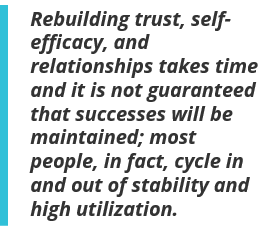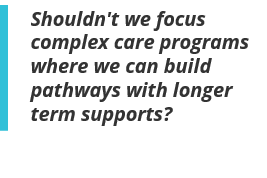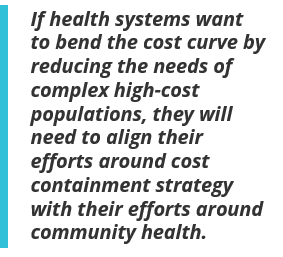By Lorie Martin, Center for Health Care Strategies
Over the last month, many in the complex care field have been abuzz about the release of the randomized controlled trial (RCT) study for the nationally recognized Camden Core Model. While the study results were not positive in terms of reducing six-month readmission rates for a very high-need subset of patients, the findings highlight critical opportunities for improving care management interventions that target highly medically and socially complex populations.
The Better Care Playbook recently spoke with David Labby, MD, PhD, health strategy advisor for Health Share of Oregon, long-time innovator of care improvements for vulnerable populations, and member of the Playbook Advisory Group, who shared his perspectives on the implications of the Camden Coalition’s RCT results.
Q: What are your biggest takeaways from the Camden Coalition RCT study?
A: Complex care is a field in transition. Many of us began with the simple notion that if we engaged with individuals with complex needs in an intensely patient-centered way, we could understand what they really need and refer them to appropriate services, which would help stabilize them. After our care management intervention, they would graduate with improved outcomes. This was, in effect, a “diagnose and treat” medical model; one might even say an acute care model based on “fixing the problem.”
The Camden study was done testing a short-term intervention for complex patients in a very low-income community based on that early “fixing the problem” model, which I suspect many in the field have for some time recognized as having limited impact.
We have subsequently learned two very fundamental things:
- Clinical and social services to facilitate referrals are inadequate. The lack of services in many, or perhaps most, communities makes meeting needs for many in this population extremely challenging. While resources available are different across communities, the major obvious issues across the country include the lack of housing/supportive housing, problems with access to mental health and substance use treatment, and for, a significant population, insufficient post incarceration transition programs since we now understand and have documented (e.g., Camden Coalition/Hennepin County) that much of this population is involved in the criminal justice system.
The consequence of this lack of referral services is that, as the Camden response notes, our care management efforts can become a “bridge to nowhere.” It is what Elizabeth Bradley’s “Health Care Paradox” work called out a number of years ago in terms of the United States’ lack of investment in the social safety net compared to other developed countries. The Camden response calls this ecosystem issue out… but that raises another problem: can we really expect the health care system to step in and fill the social safety net gap? - Trauma is ubiquitous and impacts outcomes. The second learning comes from the experience in the field that many in Medicaid/low-income populations with complex needs have had extremely challenging lives, starting from early life, and are effectively trauma survivors. As we understand more deeply the impact of trauma on such poverty-level populations, we are learning the importance not just for trauma-informed care, but also the crucial need for referral to trauma recovery services, which are largely absent in the clinical system, including the mental health system, though they do exist and are being developed (e.g., Seeking Safety therapy, Dialectical Behavior Therapy (DBT), Eye Movement Desensitization and Reprocessing (EMDR).
Can we really expect people with this history to graduate after a time-limited care management intervention? Rebuilding trust, self-efficacy, and relationships takes time and it is not guaranteed that successes will be maintained; most people, in fact, cycle in and out of stability and high utilization.
After a life of adversity, it is likely people with complex needs will need continuous long-term recovery supports both within the health care system and the community. If substance use disorder (SUD) treatment is any indication (and probably is given the high co-occurrence of SUD in this population), complexity is likely more of a chronic care condition requiring longitudinal intervention than a limited acute care condition. We also need to recognize that trauma recovery will mostly happen in the community, with the rebuilding of social relationships and supports, providing mental health peer mentoring, rebuilding purpose, establishing employment, finding stable housing, etc. So the challenge is not simply referral to services, but also to create partnerships with culturally specific, peer-run recovery-oriented community organizations that foster and support that social reintegration, which are also absent or insufficient in most communities.
Q: What does this mean for our complex care programs and for health system investment?
A: It is unrealistic to expect health systems to take on filling the huge gaps in the social service safety net. But what we have learned does suggest some more targeted approaches. At the broadest programmatic level, we need to shift from our acute care model and vision to a recovery oriented system of care (ROSC) model, similar to the model recommended by the Substance Abuse and Mental Health Services Administration (SAMHSA) where health care is but one part of a larger continuum of services. That suggests:
- Rethinking segmentation strategies: Some health conditions are just expensive (e.g., end-stage renal disease), because we can’t cure them; some complex health situations are expensive because the systems that are needed do not exist. Shouldn't we focus complex care programs where we can build pathways with longer term supports? Our segmentation approaches could shift from looking not just at who is high risk for poor health outcomes and cost, but to identifying segments where there is a continuum of clinical and community supports that has a realistic chance of providing long-term stabilization — or where we are willing to invest or partner in creating needed supports.
- Focusing on broad system-level change: We need to look at high utilization/high needs not simply as an issue at the individual level, but perhaps more importantly as a system issue that requires a multi-sector system approach to be successful. Why wouldn't we focus on partnerships with systems that are also highly engaged with our complex care population, such as housing, criminal justice, or foster care?
- Redefining measures: A more realistic measure of success than 30/90/180 days is something like three to five years. We have to beat the established literature that documents people cycling in and out of high utilization over that period of time.
We need to fix the parts of the health care system, for which we do receive funding, that are failing the complex needs populations. This includes:
- Substance use treatment systems, which have been on the margins both of health care and of health care transformation, that need to be brought up to the highest standards of evidence-based care and to embrace the ROSC model noted above. This will likely also require partnership with — and investment in — community-based organizations.
- Mental health systems, both in terms of improving access generally and more specifically to supporting development and implementation of trauma recovery services; and
- Primary care systems that need to be able to better address both the substance use and mental health issues that are now prominent in the populations they serve, both within their scope of practice and in collaboration with specialty and community providers. They also need to have more of a trauma-informed lens in terms of their approach.
Q: What community-based and cross-sector partnerships and investments are needed to support effective complex care delivery?
A: We need to create strategic partnerships with other sectors and organizations that deal with the key social risks of our complex members. This means becoming much more sophisticated in our understanding of the particular social risks of our populations using a life course view of rising risk.
Some of the risks and partnerships are clear and well documented by existing research. For example, a growing number of health systems are engaging with housing providers. What are we learning from these efforts? How do we do more of what works? What kind of investing pays off? Similarly, so many of our high-needs patients are involved in the criminal justice system. What are the best practices for transition programs? These are two areas where promising practices are emerging.
Other risks are perhaps less obvious as they occur upstream, but may actually hold more promise in that addressing them may cost less and have more impact. These include focusing on adverse childhood experiences, which are strongly associated with many of the health conditions and risk behaviors we see in complex health populations. Medicaid providers are the single universal point of contact for many young families. How can we approach screening and intervention in new ways to identify and help young families at risk in prenatal and early child practices? What partnerships with community programs/ resources can be synergistic with what we do in clinical care? Similarly, since school success is such a predictor of social success, what partnerships with schools make sense, particularly around behavioral health?
Q: How can we move from a narrow high-need focus to a community-wide, high-impact mindset?
A: While health systems cannot completely solve the large-scale social issues driving much of the needs of complex populations, they can be part of the solution for those issues that have the most impact for their business model. To the extent that community-focused investments to address social determinants of health are decided strategically — as synergistic with a population health cost and quality strategy — programs that focus on high-need, high-cost member segments are likely to move toward building the recovery-oriented systems that the Camden study demonstrates are needed.
If health systems want to bend the cost curve by reducing the needs of complex high-cost populations, they will need to align their efforts around cost containment strategy with their efforts around community health — including their investments in community benefit and increasingly around social determinants of health.




